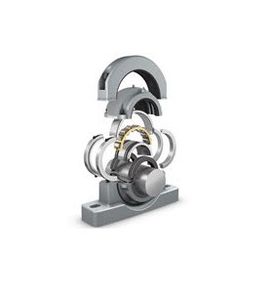
Cylindrical roller bearing double-rowfor heavy loadshigh-speed
Add to favorites
Compare this product
Characteristics
- Rolling element
- cylindrical roller
- Configuration
- double-row
- Other characteristics
- for heavy loads, high-speed, low-friction
Description
Double row cylindrical roller bearings
SKF double row cylindrical roller bearings are available in several designs with a cylindrical or tapered bore. The SKF standard assortment presented in this section includes:
NNU design bearings (fig. 1)
NN design bearings (fig. 2)
NNUP design bearings (fig. 3)
Bearing features
High load carrying capacity
Because of their second row of rollers, double row cylindrical roller bearings are suitable for heavy radial loads.
Low friction (Roller end / flange contact area)
The open flange design (fig. 4), together with the roller end design and surface finish, promote lubricant film formation resulting in lower friction and higher axial load carrying capacity.
Long service life
The logarithmic roller profile reduces edge stresses at the roller/raceway contact (fig. 5) and sensitivity to misalignment and shaft deflection.
Enhanced operational reliability
The surface finish on the contact surfaces of the rollers and raceways supports the formation of a hydrodynamic lubricant film.
Catalogs
No catalogs are available for this product.
See all of SKF AEROSPACE‘s catalogsRelated Searches
- Bearing
- Ball bearing bearing
- Steel bearing
- Roller bearing
- Corrosion-resistant bearing
- Radial bearing
- Precision bearing
- Double-row bearing
- Single-row bearing
- Angular-contact bearing
- Heavy load bearing
- Deep groove bearing
- Cage assembly bearing
- Axial bearing
- Cylindrical roller bearing
- Self-aligning bearing
- Sealed bearing
- High-speed bearing
- Stainless steel bearing
- Needle roller bearing
*Prices are pre-tax. They exclude delivery charges and customs duties and do not include additional charges for installation or activation options. Prices are indicative only and may vary by country, with changes to the cost of raw materials and exchange rates.







